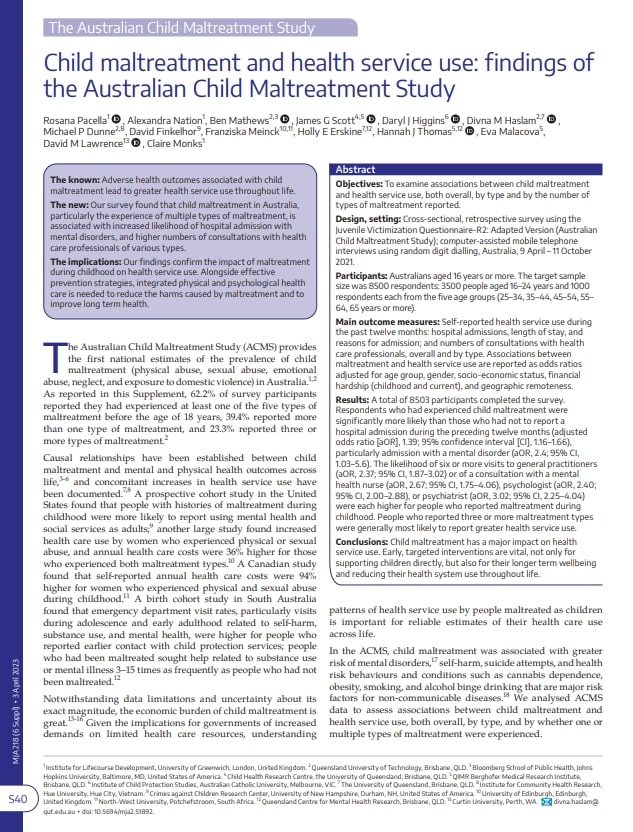Child maltreatment and health service utilisation: findings from the Australian Child Maltreatment Study
This paper, published as a part of the Medical Journal of Australia ACMS Supplement, outlines the associations between child maltreatment experiences and later health service utilisation.
Abstract
Objectives: To examine associations between child maltreatment and health service use, both overall, by type and by the number of types of maltreatment reported. Design, setting: Cross- sectional, retrospective survey using the Juvenile Victimization Questionnaire- R2: Adapted Version (Australian Child Maltreatment Study); computer- assisted mobile telephone interviews using random digit dialling, Australia, 9 April – 11 October 2021.
Participants: Australians aged 16 years or more. The target sample size was 8500 respondents: 3500 people aged 16– 24 years and 1000 respondents each from the five age groups (25– 34, 35– 44, 45– 54, 55– 64, 65 years or more).
Main outcome measures: Self- reported health service use during the past twelve months: hospital admissions, length of stay, and reasons for admission; and numbers of consultations with health care professionals, overall and by type. Associations between maltreatment and health service use are reported as odds ratios adjusted for age group, gender, socio- economic status, financial hardship (childhood and current), and geographic remoteness.
Results: A total of 8503 participants completed the survey. Respondents who had experienced child maltreatment were significantly more likely than those who had not to report a hospital admission during the preceding twelve months (adjusted odds ratio [aOR], 1.39; 95% confidence interval [CI], 1.16– 1.66), particularly admission with a mental disorder (aOR, 2.4; 95% CI, 1.03– 5.6). The likelihood of six or more visits to general practitioners (aOR, 2.37; 95% CI, 1.87– 3.02) or of a consultation with a mental health nurse (aOR, 2.67; 95% CI, 1.75– 4.06), psychologist (aOR, 2.40; 95% CI, 2.00– 2.88), or psychiatrist (aOR, 3.02; 95% CI, 2.25– 4.04) were each higher for people who reported maltreatment during childhood. People who reported three or more maltreatment types were generally most likely to report greater health service use.
Conclusions: Child maltreatment has a major impact on health service use. Early, targeted interventions are vital, not only for supporting children directly, but also for their longer-term wellbeing and reducing their health system use throughout life.
Suggested citation
Pacella RE, Nation A, Mathews B, Scott JG, Higgins DJ, Haslam DM, Dunne MP, Finkelhor D, Meinck F, Erskine HE, Thomas HJ, Malacova E, Lawrence DM, Monks C. Child maltreatment and health service utilisation: findings from the Australian Child Maltreatment Study. Med J Aust 2023; 218 (6 Suppl): S40-S46. https://doi.org/10.5694/mja2.51892
